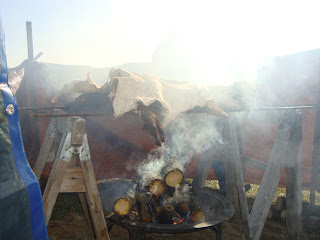It is believed that Native American groups would only use white, non-smoked buckskin infrequently for ceremonies, since it would be ruined if caught in the rain. I read an article by the author of the book, Matt Richards, who researched buckskin and believes that non-smoked was actually used frequently. I visited the American Museum of Natural History (my old stomping grounds) over break and saw a section on tanning in the Eastern Woodland Indians exhibit. There, on display, was an excellent brain-tanned hide that was completely white (and barely noticeable under a model of a village, which I naturally thought was a shame). Just something I'll keep in mind/investigate when interpreting museum collections.
I asked my Papa (that's pronounced "paw paw" for any northerners reading this post) if I could use his front yard for the smoking. All that was confirmed was that I could use it, and that I'd use a fire pit borrowed from my Aunt's cabin, but of course, when I pulled up to the house, I was greeted with this scene. My Uncle and Papa had built a tarp enclosure to help keep out wind, and already had a fire going using greenwood that was cut the previous day. Isn't family great?
 |
| The greenwood with water steaming and foaming out of it. |
We placed a BBQ grate on top of two sawhorses, then placed greenwood logs on top of that so the hide wouldn't scorch from the hot grate. Normally the smoking is done by gluing the hide into a pouch that is hung over the fire...well, since mine was too crunchy to be a pouch, this seemed like the next best idea.
The country store that my Papa started and my Uncle now runs is the white building on the left. There is a fenced-in field behind the store that is a professional croquet court, and the family country ham house (Turner Country Ham) is the building on the right. This is Fulks Run, Virginia, in Rockingham Co. My Grandmother told me that people were curious as to what was happening in the front yard. My great Uncle stopped by to test out his new camera.
 |
| It took several days for me to finally wash the smell of campfire from my hair. Usually I think it's a great smell, now reconsidering. |
 |
| Grandma also provided a mug of hot chocolate. Ahhhhh. What a life. |
The white hide before the smoking.
 The brown hide during smoking. After 2 1/2 hours I decided it was brown enough for me. As long as there's an overall color change, the step is complete, but it can be taken as far as aesthetically desired.
The brown hide during smoking. After 2 1/2 hours I decided it was brown enough for me. As long as there's an overall color change, the step is complete, but it can be taken as far as aesthetically desired.My uncle Ron was grilling pork and some ribs from the bear (see previous posts). I have to admit, it smelled much better than my "grilled" hide.
Two weeks after starting the tanning process, I was finished. Even my Grandmother pointed out that it takes a village to raise a child, and also takes a village to help that child tan a hide. I think I won't make anything out of the leather pieces, although my friend David did suggest this outfit...
Like I've mentioned, I will mostly likely run artificial aging tests on the leather to research different conservation problems. I'd also like to try out some modern tanning techniques on squirrel pelts for comparisons, but we'll see!
That's all for the brain tanning experience, but I have some ideas for other posts, so this probably won't be the end of Tanner Franner. (Yeah, that sounds extremely corny, but I'm keeping it.)







No comments:
Post a Comment